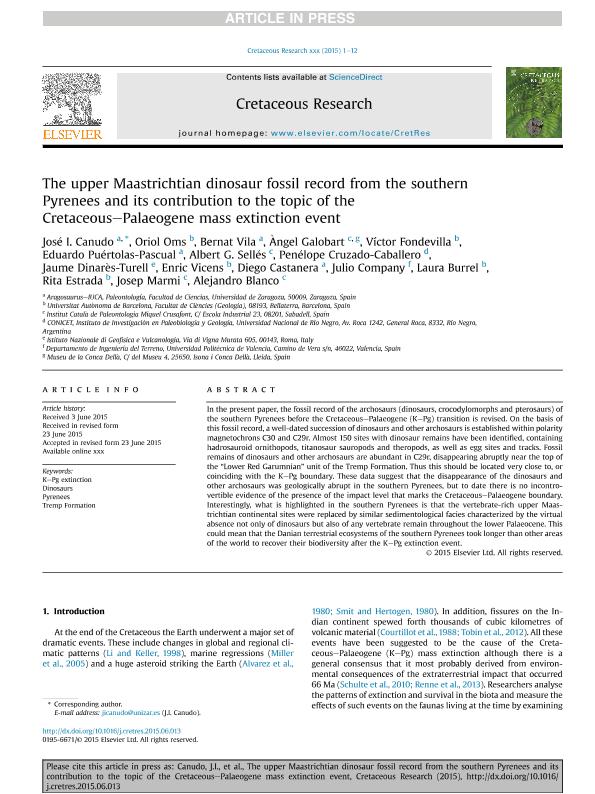Mostrar el registro sencillo del ítem
dc.contributor.author
Canudo, José I.
dc.contributor.author
Oms, Oriol
dc.contributor.author
Vila, Bernat
dc.contributor.author
Galobart, Àngel
dc.contributor.author
Fondevilla, Víctor
dc.contributor.author
Puértolas Pascual, Eduardo

dc.contributor.author
Garcia Sellés, Albert

dc.contributor.author
Cruzado Caballero, Penélope

dc.contributor.author
Dinarès Turell, Jaume
dc.contributor.author
Vicens, Enric
dc.contributor.author
Castanera, Diego
dc.contributor.author
Company, Julio
dc.contributor.author
Burrel, Laura
dc.contributor.author
Estrada, Rita
dc.contributor.author
Marmi, Josep
dc.contributor.author
Blanco, Alejandro
dc.date.available
2018-12-11T15:28:17Z
dc.date.issued
2016-01
dc.identifier.citation
Canudo, José I.; Oms, Oriol; Vila, Bernat; Galobart, Àngel; Fondevilla, Víctor; et al.; The upper Maastrichtian dinosaur fossil record from the southern Pyrenees and its contribution to the topic of the Cretaceous–Palaeogene mass extinction event; Academic Press Ltd - Elsevier Science Ltd; Cretaceous Research; 57; 1-2016; 540-551
dc.identifier.issn
0195-6671
dc.identifier.uri
http://hdl.handle.net/11336/66249
dc.description.abstract
In the present paper, the fossil record of the archosaurs (dinosaurs, crocodylomorphs and pterosaurs) of the southern Pyrenees before the Cretaceous–Palaeogene (K–Pg) transition is revised. On the basis of this fossil record, a well-dated succession of dinosaurs and other archosaurs is established within polarity magnetochrons C30 and C29r. Almost 150 sites with dinosaur remains have been identified, containing hadrosauroid ornithopods, titanosaur sauropods and theropods, as well as egg sites and tracks. Fossil remains of dinosaurs and other archosaurs are abundant in C29r, disappearing abruptly near the top of the “Lower Red Garumnian” unit of the Tremp Formation. Thus this should be located very close to, or coinciding with the K–Pg boundary. These data suggest that the disappearance of the dinosaurs and other archosaurs was geologically abrupt in the southern Pyrenees, but to date there is no incontrovertible evidence of the presence of the impact level that marks the Cretaceous–Palaeogene boundary. Interestingly, what is highlighted in the southern Pyrenees is that the vertebrate-rich upper Maastrichtian continental sites were replaced by similar sedimentological facies characterized by the virtual absence not only of dinosaurs but also of any vertebrate remain throughout the lower Palaeocene. This could mean that the Danian terrestrial ecosystems of the southern Pyrenees took longer than other areas of the world to recover their biodiversity after the K−Pg extinction event.
dc.format
application/pdf
dc.language.iso
eng
dc.publisher
Academic Press Ltd - Elsevier Science Ltd

dc.rights
info:eu-repo/semantics/openAccess
dc.rights.uri
https://creativecommons.org/licenses/by-nc-sa/2.5/ar/
dc.subject
K-Pg Extinction
dc.subject
Pyrenees
dc.subject
Tremp Formation
dc.subject
Dinosaurs
dc.subject.classification
Meteorología y Ciencias Atmosféricas

dc.subject.classification
Ciencias de la Tierra y relacionadas con el Medio Ambiente

dc.subject.classification
CIENCIAS NATURALES Y EXACTAS

dc.title
The upper Maastrichtian dinosaur fossil record from the southern Pyrenees and its contribution to the topic of the Cretaceous–Palaeogene mass extinction event
dc.type
info:eu-repo/semantics/article
dc.type
info:ar-repo/semantics/artículo
dc.type
info:eu-repo/semantics/publishedVersion
dc.date.updated
2018-07-11T15:00:55Z
dc.journal.volume
57
dc.journal.pagination
540-551
dc.journal.pais
Estados Unidos

dc.journal.ciudad
Nueva York
dc.description.fil
Fil: Canudo, José I.. Universidad de Zaragoza. Facultad de Ciencias; España
dc.description.fil
Fil: Oms, Oriol. Universitat Autònoma de Barcelona; España
dc.description.fil
Fil: Vila, Bernat. Universidad de Zaragoza. Facultad de Ciencias; España
dc.description.fil
Fil: Galobart, Àngel. Institut Català de Paleontologia Miquel Crusafont; España. Museu de la Conca Dellà; España
dc.description.fil
Fil: Fondevilla, Víctor. Universitat Autònoma de Barcelona; España
dc.description.fil
Fil: Puértolas Pascual, Eduardo. Universidad de Zaragoza. Facultad de Ciencias; España
dc.description.fil
Fil: Garcia Sellés, Albert. Institut Català de Paleontologia Miquel Crusafont; España
dc.description.fil
Fil: Cruzado Caballero, Penélope. Consejo Nacional de Investigaciones Científicas y Técnicas. Centro Científico Tecnológico Conicet - Patagonia Norte. Instituto de Investigación en Paleobiología y Geología; Argentina
dc.description.fil
Fil: Dinarès Turell, Jaume. Istituto Nazionale di Geofisica e Vulcanologia; Italia
dc.description.fil
Fil: Vicens, Enric. Universitat Autònoma de Barcelona; España
dc.description.fil
Fil: Castanera, Diego. Universidad de Zaragoza. Facultad de Ciencias; España
dc.description.fil
Fil: Company, Julio. Universidad Politécnica de Valencia; España
dc.description.fil
Fil: Burrel, Laura. Universitat Autònoma de Barcelona; España
dc.description.fil
Fil: Estrada, Rita. Universitat Autònoma de Barcelona; España
dc.description.fil
Fil: Marmi, Josep. Institut Català de Paleontologia Miquel Crusafont; España
dc.description.fil
Fil: Blanco, Alejandro. Institut Català de Paleontologia Miquel Crusafont; España
dc.journal.title
Cretaceous Research

dc.relation.alternativeid
info:eu-repo/semantics/altIdentifier/url/https://www.sciencedirect.com/science/article/pii/S0195667115300173
dc.relation.alternativeid
info:eu-repo/semantics/altIdentifier/doi/https://doi.org/10.1016/j.cretres.2015.06.013
Archivos asociados
